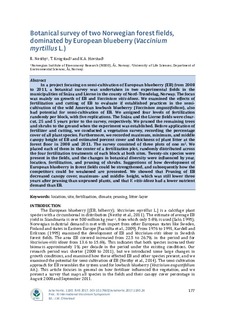| dc.description.abstract | n a project focusing on semi-cultivation of European blueberry (EB) from 2008 to 2011, a botanical survey was undertaken in two experimental fields in the municipalities of Snåsa and Lierne in the county of Nord-Trøndelag, Norway. The focus was mainly on growth of EB and Vaccinium vitis-idaea. We examined the effects of fertilization and cutting of EB to evaluate if established practices in the semicultivation of the wild American lowbush blueberry (Vaccinium angustifolium), also had potential for semi-cultivation of EB. We assigned four levels of fertilization randomly per block, with five replications. The Snåsa and the Lierne fields were clearcut, 25 and 5 years prior to the survey, respectively. We pruned the remaining trees and shrubs to the ground when the experiment was established. Before application of fertilizer and cutting, we conducted a vegetation survey, recording the percentage cover of all plant species. Furthermore, we recorded maximum, minimum, and middle canopy height of EB and estimated percent cover and thickness of plant litter at the forest floor in 2008 and 2011. The survey consisted of three plots of one m2. We placed each of them in the center of a fertilization plot, randomly distributed across the four fertilization treatments of each block at both sites. Twenty-six species were present in the fields, and the changes in botanical diversity were influenced by year, location, fertilization, and pruning of shrubs. Suggestions of how development of European blueberry in forest fields could be strengthened, and subsequently how the competitors could be weakened are presented. We showed that Pruning of EB decreased canopy cover, maximum- and middle- height, which was still lower three years after pruning than unpruned plants, and that V. vitis-idaea had a lower nutrient demand than EB. | nb_NO |

